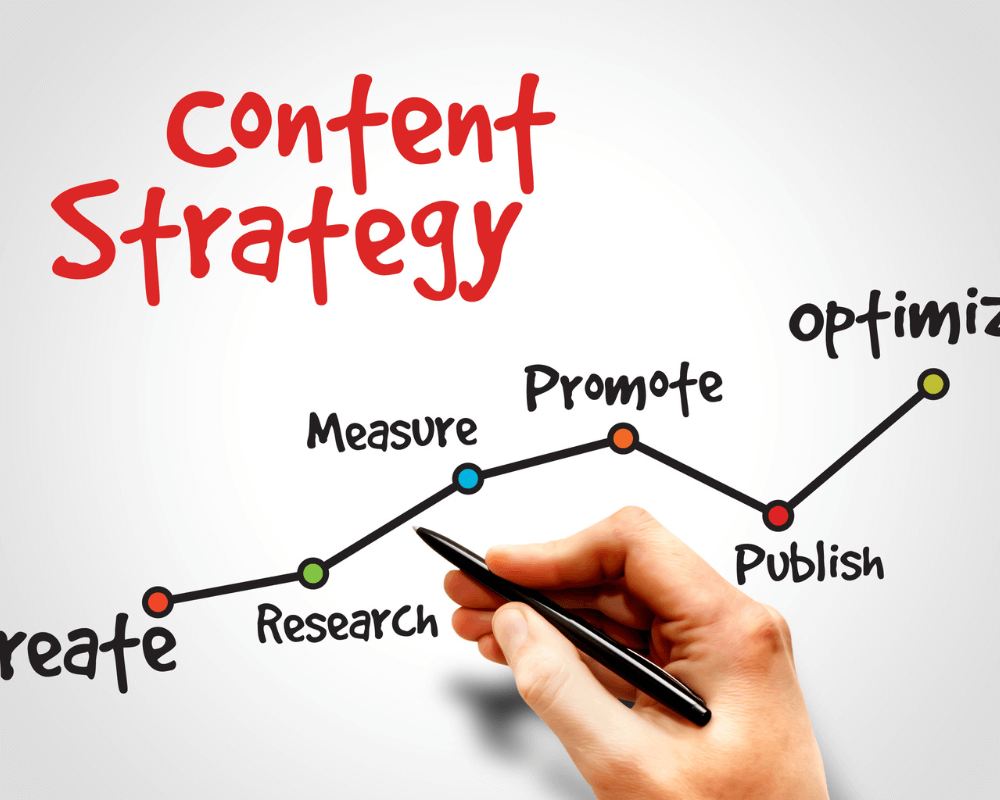Using content marketing effectively can significantly grow your business. By creating high-quality, valuable content tailored to your audience, you can attract and retain customers, driving conversions and increasing brand awareness. Content marketing aligns your content with your business goals, ensuring each piece serves a strategic purpose.
To start, identify the needs and interests of your target audience. This helps you produce relevant content that engages readers and positions your brand as an authority. Consistency in your messaging and publishing schedule is also crucial for building trust and maintaining interest.
Measuring the performance of your content is essential to understand its impact. Use analytics to track metrics like engagement, traffic, and conversions, then adjust your strategy accordingly. This data-driven approach allows you to optimize your content marketing efforts and achieve better results for your business.
Understanding content marketing

Content marketing is essential for fostering trust and engagement with your audience. Leveraging AI can significantly enhance your strategy by improving efficiency and personalization.
Principles of content marketing
The core principles focus on delivering valuable, relevant content to attract and retain a well-defined audience. Quality over quantity is vital, ensuring your content is informative and engaging. Consistency in posting helps build trust and keeps your audience engaged.
You should aim to educate rather than overtly sell, positioning your brand as an authority in your field. Various formats, such as blogs, videos, and infographics, can cater to different preferences. Monitoring metrics such as engagement rates and conversion rates helps measure success and tweak strategies as needed.
The role of AI in content marketing
AI plays a crucial role in optimizing content marketing efforts. It can help analyze vast amounts of data to identify trends and insights quickly. Personalization is a key benefit, allowing you to tailor content to specific audiences based on their behavior and preferences. AI tools can automate content creation processes, saving time and resources while maintaining consistency.
Machine learning algorithms can predict what content will perform best, enhancing engagement rates. Integrating AI can also improve customer interaction through chatbots and personalized recommendations, further building trust and engagement.
Developing your content marketing strategy

Creating a successful content marketing strategy requires clear goals, a thorough understanding of your target audience, and a realistic assessment of your resources and budget.
Setting clear marketing goals
Defining your marketing goals is the first step. These goals should be specific, measurable, achievable, relevant, and time-bound (SMART). Focus on what you want to achieve, whether it’s increasing brand awareness, driving website traffic, or boosting conversions.
Example goals:
- Increase website traffic by 20% in 6 months
- Grow email subscriber list by 500 within 3 months
- Generate 50 new leads per month
By setting clear goals, you create a roadmap that guides your content strategy and helps measure success.
Research and understanding your target audience
Understanding who your target audience is and what they care about is crucial. Creating detailed buyer personas can help. These personas should include demographics, interests, pain points, and buying behaviors. Research tools like surveys, social media analytics, and competitors’ strategies can provide valuable insights.
Key elements of a buyer persona:
- Demographics: Age, gender, income, education
- Interests: Hobbies, favorite media channels
- Pain points: Challenges and problems they face
- Buying behavior: How they make purchase decisions
This understanding enables you to tailor your content to meet the needs and preferences of your audience, increasing engagement and conversions.
Evaluating your resources and budget
To execute your content marketing strategy effectively, assess your available resources and budget. This includes your team’s skills, the time they can commit, and the financial resources at your disposal. Identify any gaps in your resources and find solutions, such as outsourcing or investing in marketing tools.
Considerations for evaluating resources:
- Team skills: Writing, SEO, graphic design, social media management
- Tools: Content management systems, analytics platforms, design software
- Budget: Allocation for content creation, paid ads, software
Understanding your resources and budget helps ensure that your strategy is realistic and sustainable, maximizing your ROI.
Crafting your content strategy

Creating a comprehensive content strategy involves selecting appropriate content types, focusing on effective keyword research and SEO best practices, and organizing your efforts through an efficient content calendar. This ensures that your content aligns with your business goals and reaches your target audience effectively.
Choosing the right types of content
Selecting the correct types of content is essential for engaging your audience and meeting your business goals. Consider various formats such as blog posts, videos, infographics, podcasts, or social media posts. Each type can serve different purposes. For instance, blog posts are great for SEO and driving traffic, while videos may increase engagement on social platforms.
Understand your audience’s preferences and adapt accordingly. Diversify your content types to capture different segments of your market and keep your audience interested.
Keyword research and SEO best practices
Keyword research is foundational for making your content discoverable. Use tools like Google Keyword Planner, Ahrefs, or SEMrush to identify keywords relevant to your industry. Focus on both short-tail and long-tail keywords. Integrate these keywords naturally into your content, including titles, headers, and meta descriptions.
Emphasize quality over quantity, ensuring your content is informative and valuable. Backlinks and internal linking help boost your site’s credibility and SEO rankings. Structure your content clearly so it’s easily readable and searchable by both users and search engines.
Creating a content calendar
An editorial calendar helps manage your content production and publication schedule effectively. Start by outlining your business goals and aligning your content topics with important dates, such as product launches or holidays. Use tools like Trello, Asana, or Google Calendar to organize your timeline.
Specify who is responsible for each task, set deadlines, and plan editorial reviews. Consistency in publishing helps build a loyal audience. A well-structured calendar ensures you stay on track, maintaining a steady flow of content that supports your overall content strategy.
Producing high-quality content

To produce high-quality content, focus on storytelling, diverse content formats, and expert collaboration. These elements ensure engaging, valuable material for your audience.
The art of storytelling
Effective storytelling drives audience engagement. Craft narratives that resonate with your target audience’s interests and needs. A well-told story captivates readers and imparts your message in a memorable way. Start with a compelling hook. This draws readers in and encourages them to continue.
Use clear and relatable characters or scenarios. These elements help your audience connect on a personal level. Maintain a consistent tone and style throughout your content. This creates a cohesive reading experience. Incorporating real-life examples and case studies enhances relatability, making your content more trusted and effective.
Incorporating different content formats
Utilizing multiple content formats broadens your reach. Different audiences prefer different types of content. Some may engage more with videos, while others prefer podcasts or written articles. Videos are highly engaging. Create tutorials, behind-the-scenes clips, or webinars. These formats are effective for demonstrating complex ideas clearly. Podcasts offer convenience. Listeners can consume content while multitasking.
Produce episodes that provide valuable insights or interviews with thought leaders in your industry. Infographics and interactive content break down complex information, making data digestible and engaging. Free formats like blog posts, whitepapers, and social media updates cater to different consumption preferences.
Collaborating with experts and influencers
Working with experts and influencers boosts your content’s credibility. Readers value insights from trusted industry figures. Collaboration can take various forms, such as guest blog posts, video interviews, or podcast features. Identify potential collaborators who align with your brand values. Reach out with a clear proposal that outlines mutual benefits.
Provide opportunities for them to share their expertise with your audience. Feature quotes, case studies, or co-created content. This technique leverages their authority and network. Collaborations also introduce your brand to new audiences, expanding your reach and influence effectively.
Content publishing and distribution

Strategic content publishing and effective distribution are key to reaching your target audience and maximizing engagement. To enhance visibility and drive traffic, utilize social media platforms, email marketing, and a combination of owned and paid channels.
Effective use of social media platforms
Publishing content on social media platforms like Facebook and YouTube can significantly boost your reach. Each platform has its unique audience and preferred content formats.
Facebook: Visual content like images and videos performs well. Use Facebook Groups and Pages to engage directly with your audience.
YouTube: Focus on creating high-quality and informative videos. Optimize titles, descriptions, and tags to improve discoverability. Sharing your YouTube videos on other social networks can expand your reach. Consistency in posting, using relevant hashtags, and engaging with your followers are crucial. Monitor analytics to understand what content resonates most and adjust your strategy accordingly.
Email marketing strategies
Email marketing remains one of the most effective distribution channels. Build an email list by offering value, such as exclusive content or discounts. Use segmented lists to tailor content to different audience segments. This increases engagement and reduces unsubscribe rates.
Emails should be visually appealing and mobile-friendly. They should also include clear calls to action (CTAs) and personalize the content as much as possible. Test different subject lines, send times, and content formats to find what works best for your audience.
Leveraging owned and paid channels
Owned channels, such as your website and blog, are critical for content hosting and long-term engagement. Optimize your website for search engines to drive organic traffic. Paid channels, including ads on social media platforms and Google Ads, can amplify your reach.
Target specific demographics to ensure your content reaches the right audience. Create a comprehensive distribution strategy using a mix of owned and paid channels. Align your messaging across all channels to maintain consistency and reinforce your brand identity.
Measuring and analyzing content performance

Focusing on key metrics such as engagement rates, traffic statistics, and conversion rates is crucial for effectively measuring content performance. Leveraging analytics tools helps refine content strategies and boost success by identifying what resonates with your audience.
Using analytics to refine content approaches
Analyzing data from your content is vital. Tools like Google Analytics and social media insights can provide valuable metrics on traffic, engagement, and conversion rates.
- Engagement rates: Measure likes, comments, shares, and time spent on the content.
- Traffic statistics: Evaluate page views, unique visitors, and source of traffic.
- Conversion rates: Determine how many leads or sales have been generated from the content.
Use this data to understand what type of content drives the most success. Adjust your strategy based on which pieces yield high engagement and conversion rates, thereby optimizing your ROI and improving overall business growth.
Cultivating customer relationships

Creating meaningful connections with your audience fosters trust and loyalty, paving the way for engaging interactions that drive conversions. Strategically leveraging content marketing builds these bonds effectively.
Building trust and loyalty through content
You can build trust and loyalty by consistently providing valuable, relevant content. Educational articles, insightful blogs, and helpful guides position your business as an authoritative source. This consistent delivery assures customers that you understand their needs.
Transparency is key. Share behind-the-scenes looks and case studies to showcase your processes and success stories. This openness fosters credibility. Regularly update your content to address current trends and issues. Using customer testimonials reinforces reliability and encourages new audience members to trust your brand.
Engaging with the audience to drive conversions
Engagement goes beyond content delivery; it involves active participation. Respond promptly to comments and messages. This interaction shows that you value their input and are attentive. Use interactive content like polls, quizzes, and surveys to involve customers.
These tools not only entertain but also provide valuable insights into users’ preferences. Incorporate user-generated content to boost engagement and trust. Calls to action (CTAs) should be strategically placed within your content. Guide your audience toward desired actions, such as signing up for newsletters or making purchases, ensuring that the journey from interest to conversion is seamless.
Scaling your content marketing efforts

To grow your business using content marketing, you need to scale efficiently. This involves leveraging automation, outsourcing tasks, and expanding your reach to new markets.
Leveraging automation and outsourcing
Automation can save significant time. Use tools like Hootsuite or Buffer to manage social media posts and email marketing campaigns. Automating these processes can help maintain consistency and frequency of content. Outsourcing is essential for tasks that require specialized skills.
Freelance content marketers or content agencies can handle writing, graphic design, and video production, allowing you to focus on strategy and growth. Start with a clear plan outlining tasks to be automated or outsourced. Identify repetitive or time-consuming tasks. Utilize task management tools to streamline the workflow.
Expanding to new markets and audiences
Expanding to new markets involves market research. Identify potential customers in different regions or demographics online. Tailor your content to meet the cultural and language needs of these new audiences. Localize your content by translating and adapting it for different markets. Use SEO strategies to rank in local search results.
Collaborate with influencers or local content creators to boost your credibility and reach. Entering global markets requires a strategic approach. Plan content calendars that consider local holidays and trends. Scale up your content production to meet the increased demand.

